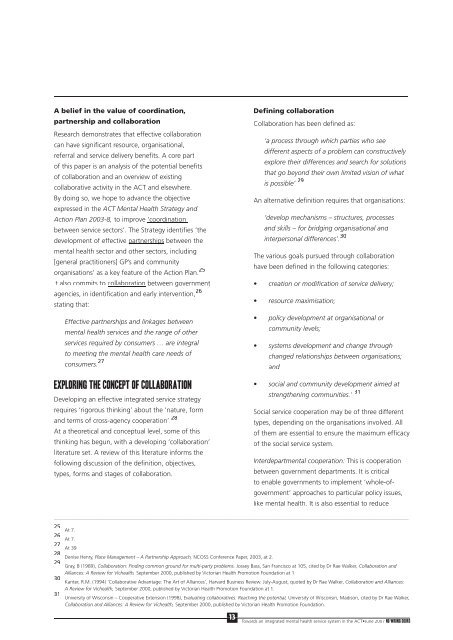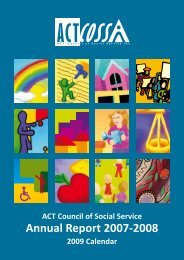actcoss text final.indd - ACT Council of Social Service
actcoss text final.indd - ACT Council of Social Service
actcoss text final.indd - ACT Council of Social Service
You also want an ePaper? Increase the reach of your titles
YUMPU automatically turns print PDFs into web optimized ePapers that Google loves.
A belief in the value <strong>of</strong> coordination,<br />
partnership and collaboration<br />
Research demonstrates that effective collaboration<br />
can have significant resource, organisational,<br />
referral and service delivery benefits. A core part<br />
<strong>of</strong> this paper is an analysis <strong>of</strong> the potential benefits<br />
<strong>of</strong> collaboration and an overview <strong>of</strong> existing<br />
collaborative activity in the <strong>ACT</strong> and elsewhere.<br />
By doing so, we hope to advance the objective<br />
expressed in the <strong>ACT</strong> Mental Health Strategy and<br />
Action Plan 2003-8, to improve ‘coordination<br />
between service sectors’. The Strategy identifies ‘the<br />
development <strong>of</strong> effective partnerships between the<br />
mental health sector and other sectors, including<br />
[general practitioners] GP’s and community<br />
organisations’ as a key feature <strong>of</strong> the Action Plan. 25<br />
It also commits to collaboration between government<br />
agencies, in identification and early intervention, 26<br />
stating that:<br />
Effective partnerships and linkages between<br />
mental health services and the range <strong>of</strong> other<br />
services required by consumers … are integral<br />
to meeting the mental health care needs <strong>of</strong><br />
consumers. 27<br />
EXPLORING THE CONCEPT OF COLLABORATION<br />
Developing an effective integrated service strategy<br />
requires ‘rigorous thinking’ about the ‘nature, form<br />
and terms <strong>of</strong> cross-agency cooperation’. 28<br />
At a theoretical and conceptual level, some <strong>of</strong> this<br />
thinking has begun, with a developing ‘collaboration’<br />
literature set. A review <strong>of</strong> this literature informs the<br />
following discussion <strong>of</strong> the definition, objectives,<br />
types, forms and stages <strong>of</strong> collaboration.<br />
Defining collaboration<br />
Collaboration has been defined as:<br />
‘a process through which parties who see<br />
different aspects <strong>of</strong> a problem can constructively<br />
explore their differences and search for solutions<br />
that go beyond their own limited vision <strong>of</strong> what<br />
is possible’. 29<br />
An alternative definition requires that organisations:<br />
‘develop mechanisms – structures, processes<br />
and skills – for bridging organisational and<br />
interpersonal differences’. 30<br />
The various goals pursued through collaboration<br />
have been defined in the following categories:<br />
• creation or modification <strong>of</strong> service delivery;<br />
• resource maximisation;<br />
• policy development at organisational or<br />
community levels;<br />
• systems development and change through<br />
changed relationships between organisations;<br />
and<br />
• social and community development aimed at<br />
strengthening communities.’ 31<br />
<strong>Social</strong> service cooperation may be <strong>of</strong> three different<br />
types, depending on the organisations involved. All<br />
<strong>of</strong> them are essential to ensure the maximum efficacy<br />
<strong>of</strong> the social service system.<br />
Interdepartmental cooperation: This is cooperation<br />
between government departments. It is critical<br />
to enable governments to implement ‘whole-<strong>of</strong>government’<br />
approaches to particular policy issues,<br />
like mental health. It is also essential to reduce<br />
___________________________________________________________________________________________________________________________<br />
25 At 7.<br />
26 At 7.<br />
27 At 39.<br />
28 Denise Henry, Place Management – A Partnership Approach, NCOSS Conference Paper, 2003, at 2.<br />
29 Gray, B (1989), Collaboration: Finding common ground for multi-party problems. Jossey Bass, San Francisco at 105, cited by Dr Rae Walker, Collaboration and<br />
Alliances: A Review for Vichealth, September 2000, published by Victorian Health Promotion Foundation at 1.<br />
30 Kanter, R.M. (1994) ‘Collaborative Advantage: The Art <strong>of</strong> Alliances’, Harvard Business Review. July-August, quoted by Dr Rae Walker, Collaboration and Alliances:<br />
A Review for Vichealth, September 2000, published by Victorian Health Promotion Foundation at 1.<br />
31 University <strong>of</strong> Wisconsin – Cooperative Extension (1998), Evaluating collaboratives: Reaching the potential, University <strong>of</strong> Wisconsin, Madison, cited by Dr Rae Walker,<br />
Collaboration and Alliances: A Review for Vichealth, September 2000, published by Victorian Health Promotion Foundation.<br />
13 Towards an integrated mental health service system in the <strong>ACT</strong>•June 2007 NO WRONG DOORS













